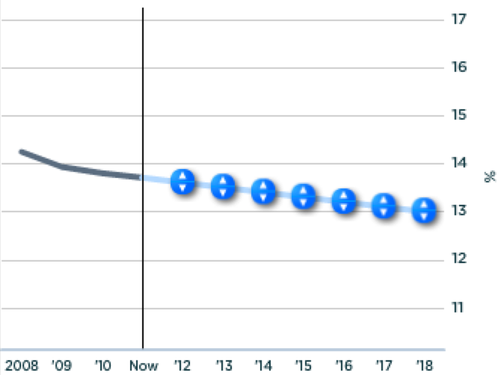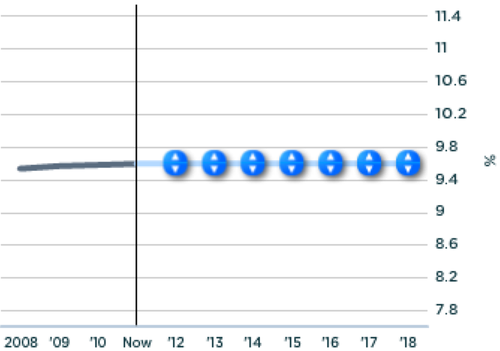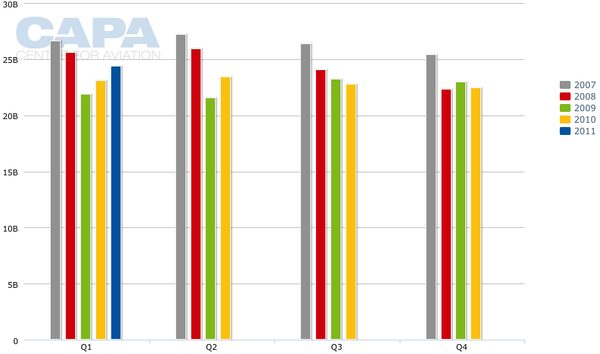Drum beat grows louder for strategy change at loss-making American Airlines
American has been taking heat in the past month amid analyst complaints about its underperformance and its lack of a flight plan for success. Indeed, its stock dropped 41% yesterday as more than one analyst suggested it put itself out of its misery and file for bankruptcy.
Thus is after a number of other analysts signalled they lost patience with management over a year ago and, more recently, called for management to step aside for the sake of the company. Compounding the recession fears was the fact pilot retirements are 10 times the monthly norm as contract provisions allow pilots to take the best share price of the previous 60 days, signalling they are trying to protect their share price-based pensions.
Talk of a double-dip recession and suggestions that revenue slowed in the last two weeks prompted Citi analyst Will Randow downgraded US Airways from hold to sell and United Continental from buy to hold.
Even as they sent stock prices up and down over the last few weeks, some analysts said American's liquidity gives it time to turn around this giant ship of state. For its part, management is resisting a bankruptcy filing for much the same reason it did in 2003 despite four years of losses that is expected to be followed by a fifth next year.
The airline said there is no company-driven news that would prompt the share price to fall so dramatically, which triggered an automatic pause in AMR trading.
"Regarding rumors and speculation about a court-supervised restructuring, that is certainly not our goal or our preference," said the company again. "We know we need to improve our results, and we are keenly focused as we work to achieve that."
Profit record is dismal
American has incurred USD12.4 billion in losses since 2001 with another USD1.2 billion loss expected this year and USD600 million next year. The tenor of the growing impatience can be seen in the questions posed to Treasurer Beverly Goulet at the recent Deutche Bank Transportation Conference. The questions included declaring bankruptcy as well as whether its current strategy is losing its market share to Delta and United who, with their mergers, have a much more compelling product to present corporate travelers.
At least one analysis shows the answer is yes and that will continue. American's domestic market share will drop to 13% in 2018 from its current 14.3% while international remains flat. The Trefis analysis cited increasing low-cost-carrier competition on the domestic side.
American Airlines' US market share
Its international market share rose from 9.5% in 2008 to 9.6% in 2010, an anaemic pace which is expected to continue, according to Trefis, which said the share loss has meant gains for both United Continental and Delta.
American Airlines' international market share
Another question posed during the conference centred on the well-known criticism as to why American continues to insist on serving marginal routes while other airlines retreat to fortress hubs they dominate as they build their post-recession strength. Here again, though, is the difference between American's refusal to follow the industry into bankruptcy in the last decade and its competitors who did.
Avondale Partners analyst Bob McAdoo said the airline's 10 worst routes lose USD450 million per year before this year's oil price hike. The airport cited during the questioning was Los Angeles, a key part of the company's corner-stone strategy and which is a hyper-competitive market, as are two of its other corner-stone markets: Chicago and New York.
Ms Goulet was also criticised for blaming labour but it is the continuing negotiations with pilots that is keeping it from achieving many of the cost-cutting measures that bankruptcy allowed its competitors to achieve.
This means the resolution of its pilot contract, already years in the making, becomes critical to turning the airline around. It needs the new contract not only to acquire its new aircraft but also to shed marginal, long-haul transcontinental and international routes. It needs scope relief to purchase large regional jet capacity from regionals and to make feeder operations, used to build its hub connections in its cornerstone markets, more profitable by getting rid of the high-cost 50-seat-and-below aircraft.
Worries of a double-dip recession continue to keep the fate of US airlines in question. As US Airways CEO Doug Parker says, this is a different industry than it was before the 2008 economic meltdown, one much better positioned to weather potential economic storms. And this includes American because of its liquidity.
Mega aircraft order did nothing to assuage critics
The onslaught of diminishing expectations for the Dallas-based carrier is not new but it was compounded when American announced its huge aircraft order, in what has turned out to be a Hail Mary pass that fumbled with analysts despite its off-balance sheet financing. Most were unimpressed, saying the aircraft, unless they came with a new flight plan for success, would not change their opinions about the only US airline that remains unprofitable.
The mega order did nothing to blunt criticism because it came on the day the carrier announced USD286 million in losses for the second quarter while United Continental posted profits of US538 million and Delta posted USD198 million in profits, regaining profitability. Its news that revenues rose 7.8% was completely overwhelmed by its losses.
American disagrees its mega order would not be effective, saying it is a key part of the strategy to reduce fuel costs - up USD500 million in the first quarter year on year - by about 50% over its oldest aircraft. After all, the entire industry is re-fleeting. Delta in Aug-2011 placed a modest narrowbody order and United is expected to place an order soon. American's aging fleet means low productivity on the aircraft given its higher maintenance needs, which only bolsters its comments about a 50% cut in fuel.
American criticised, United lauded
American remains weak but its order will help strengthen it. Analysts want to see it make more profits out of current aircraft than buy newer equipment, but that is easier said than done with high fuel. After all, Boeing and Airbus signaled their confidence in American when they hammered out their deals even if it were to keep their competitive positions in the USD1.7 billion narrowbody aircraft market in the US.
The order also addresses American's competitive stance in lowering costs nearer to its peers. MIT Research Engineer Bill Swelbar calculated the estimated lease cost at USD400,000 per month was partially offset by the USD370,000 in fuel and maintenance costs savings.
Furthermore, he said with the reported discounts made on the aircraft, lease costs could be lower than the estimated fuel and maintenance savings, making the economics even more compelling. Mr Swelbar pointed out that this does not count ancillary revenue possibilities from IFE, crew cost efficiencies from a simpler fleet once complexity costs are addressed, crew cost savings from a more reliable fleet and new passenger acceptance. That said, the entire package then makes American's decision look quite different, especially with respect to fixing its balance sheet, he suggested.
The aircraft deal was definitely sweet - around USD30-40 million per unit - according to American's 10Q filing. But the order blossomed from the original plan calling for the replacement of 300 aircraft at about 45-50 aircraft annually. This is far below the 460-aircraft it has ordered, and with the 465 options it has taken it would be closer to 925 aircraft.
Its initial schedule of MD-80 replacement with the 737 was not fast enough despite taking 91 new aircraft since 2009. It is also scheduled to take another 39 through 2013 when its mega order deliveries begin. Airbus's package included as much as USD6 billion in financing while Boeing's was also aggressive.
Bankruptcy suggested
Clearly management has a different picture of the future than do analysts' too-heavily-focused-on-the-short-term expectations. After the initial deliveries of the new aircraft, American plans to either expand with more deliveries from the mega order or replace more aircraft, but the likelihood is that it will be both.
American's differing vision is a problem on Wall Street. Investors have clearly lost confidence in AMR CEO Gerard Arpey and President Tom Horton and have been waiting - not so patiently, anymore - for them to come up with clear-cut plans on how the company plans to dig itself out of its very deep financial hole. Flight Plan 2020 - its cornerstone, focus-on-business-travelers plan and joint business development - are not the answer, according to analysts, who say they would have preferred a new survival plan to American's mega aircraft order.
In fact, Maxim Group's Ray Neidl indicated management has yet to adapt to industry changes its peers have long since adopted. Despite being a good franchise, he said in his latest report on the company, it is "under-managed. Management seems to be more of a caretaker of a deteriorating asset".
Its failure to adapt as its peers have done may be behind calls for bankruptcy since it was that action that helped other US carriers to restructure their costs.
Mr Neidl said AMR's problems are fixable but doubted current management was up to the task. It was he who frankly asked whether they'd be willing to step aside in the interests of the company.
JP Morgan's Jamie Baker said the third-quarter EBIT margin of 1.7%, suggested as a result of AMR's robust third quarter projections, still trails the industry by 800 bps and would be the third consecutive year its third-quarter margin deficit worsened compared to its peers. He also said the new aircraft mortgage offering was critical to getting the airline through its seasonally low periods.
But the second quarter margin, according to CreditSights Roger King who spoke to The Wall Street Journal, was a third that of United and half that of Delta, both of whom have consolidated to into much healthier airlines with robust outlooks.
For their part, executives have spent this year trying to fight back. In all its economic releases it points to the improvement since 2006 and has sought to bolster management capabilities by noting that improvement has come on their watch. But Mr Baker doesn't buy it, pointing out American's margin deficit dates back to 2004.
Bankruptcy being pushed
The B word - bankruptcy - has been mentioned more than once in the last month, although analysts doubt its necessity because the airline is not now facing a liquidity crisis and because it continues to build its coffers. They suggest the company still has a couple of years to turn around, thus the impatience with its management.
While its liquidity dropped by about USD900 million in the last few months, it newest money-raising action mortgaging aircraft is anticipated to bring in USD725 million. It filed with the Securities and Exchange Commission to issue Class A pass-through certificates covering 14 B737-800s and 14 B757-200s delivered between 1999 and 2001, two more B737-800s delivered in 2009 and 13 B777-200ERs delivered in 2001. It also said it may raise another USD232 million with Class B certificates. The aircraft have an appraised value of USD1.59 billion.
Its third-quarter guidance indicated it spent USD1.1 billion in cash in the year ending 30-Jun and unrestricted cash will be USD4.7 billion at the end of the third quarter. JP Morgan anticipates the aircraft deal should mean the carrier will end the year with USD3.5 million in liquidity, 15% of annual revenue. Any figure over 10% is considered under-performing.
If it burns through USD1.1 billion in cash each year, liquidity will likely worsen. Even so, Rodman & Renshaw analyst Dan McKenzie forecast USD4.4 billion in liquidity at the end of 2012 not far from where it is now. It now has net debt of approximately USD12 billion with less than USD1 billion in market capitalization. He also noted, however, the company faces USD6.37 billion in debt payments through 2015, USD1.8 billion due next year. Indeed, Moody's recently downgraded the airline's credit citing USD3.1 billion in debt due before the end of 2012 further diminishing liquidity at a time when new financing is not easy to come by.
American Airlines total liabilities and stockholders' equity
Bankruptcy rumors were prompted by a question to Ms Goulet who did not immediately dismiss questions about Chapter 11 as she did for Chapter 7. Her answer sounded just like other responses from American and can be summed up as asking for more patience.
"Frankly we'll have to let our results do the talking for us, and we're optimistic that the steps we're taking will move us in that direction," she responded. But that is precisely the reason analysts are so restive.
Interestingly, it has been suggested that a bankruptcy filing could signal an impending merger since removing its unattractive components would make it more attractive. American President Tom Horton last summer mentioned International Group, parent to fellow oneworld members British Airways and Iberia, but that match faces foreign ownership hurdles. Even so, he suggested those rules are ripe for change and such a merger could happen in his "working lifetime".
Nice guys finish last
American is justly proud of avoiding bankruptcy, and labour should be justly proud of their role in that when, in 2003, they agreed to USD1.6 billion in annual concessions. Employees at the bankrupt carriers saw pensions evaporate, along with so much more, forcing them to conclude they were duped especially as prospects for being made whole once the economy turned have now evaporated for all but the most delusional.
The Allied Pilots Association was quick to come out saying bankruptcy is not in any of the scenarios now being negotiated, has not been mentioned by management as an option and they are not negotiating a concessionary contract. They acknowledged, however, that the company cannot continue to lose money. In the end, they were upbeat that bankruptcy can be avoided if "a number of economic trends fall into place". Even so, APA has engaged advisors on bankruptcy and other options if the carrier does go in that direction.
Pilot losses mount
But members are voting with their feet, fearing additional declines in AMR stock on which their pensions are based. Some 111 retired at the end of August with another 129 at the end of September. The carrier expects 300 to 400 to retire by year end, thus the reason for upping their capacity cuts in the fourth quarter. The August retirements were ten times the normal monthly average and four times the peak retirements experienced in 2010.
Management is equally reticent to turn to bankruptcy. CEO Gerard Arpey, when asked if he regretted not playing the bankruptcy card when his peers did, said "never". He explained during the second-quarter analyst call, that competitive advantages gained by the rest of the industry were only temporary. Even so, they are enough to keep AMR down and more than enough for one analyst to dismiss the argument, saying waiting for labour costs to rise at the other airlines is not a strategy for success or even a strategy.
That cost disadvantage is unlikely to be closed during this round of contract negotiations, making a near-term closing of the labour-cost gap difficult. About all it can hope for is easing work rules to boost productivity.
No new success plans
To date, American has produced its Flight Plan 2020, which has not produced results as fast as the airline expected. Nor has its joint business with British Airways and Iberia. Its joint business with Japan Airlines is still too new.
Before its approval, American was touting the BA/Iberia business as capable of producing USD500 million in revenues. By the time its JAL joint business was announced, that USD500 million was the combined gains from the BA/Iberia and JAL joint businesses as well as Flight Plan 2020, seriously compromising the expectations for the company.
No doubt all these things will contribute to revenues but analysts seem to be saying they question whether or not it will be enough.
American's upbeat, third-quarter projections did little to ameliorate critics. Revenues per available mile are expected to rise between 7.8% and 8.8% year on year in the third quarter. Increasing revenue metrics was offset by a USD25 million loss from Hurricane Irene and its pronouncement it will take large write-down on the falling value of its aging fleet later this year. Exacerbating this was it prediction that cost per available seat mile would rise between 9.2% and 10.2%, mostly on jet fuel but other costs as well.
Its 460-aircraft order was perhaps seen as too little, too late but it could hardly have fielded such an order earlier given its financial metrics. And, given fuel costs it can hardly have waited longer. Indeed, it wouldn't have been able to now had it not been for huge participation from the manufacturing and lessor communities.
The question now becomes whether management can regain the confidence of the usually impatient Wall Street. Analysts are becoming increasingly vocal as American fails to provide any reason they should turn their opinion around. For now, American will continue to bump along but it will be the new pilot contract that will tell its future. Until then, as with the airline performance itself, criticism will likely get worse before it gets better.


